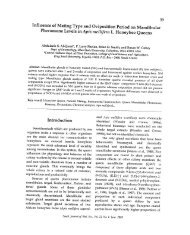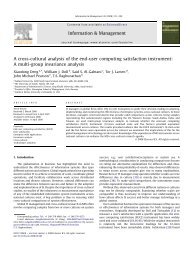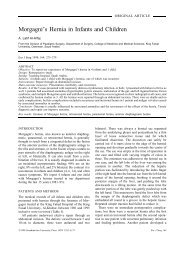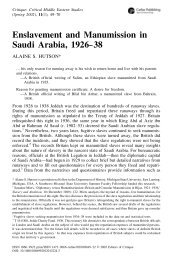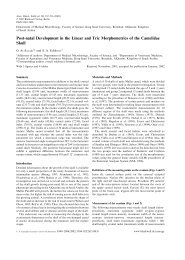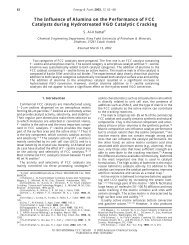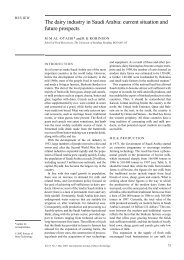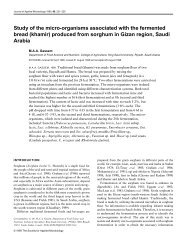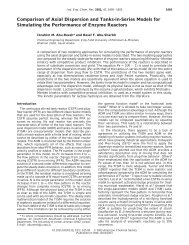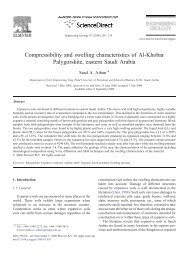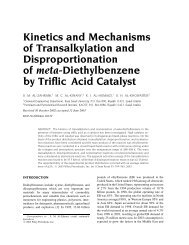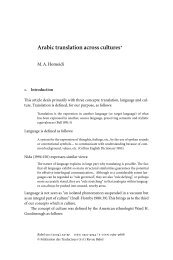Role of racemization in optically active drugs development
Role of racemization in optically active drugs development
Role of racemization in optically active drugs development
Create successful ePaper yourself
Turn your PDF publications into a flip-book with our unique Google optimized e-Paper software.
454 ALI ET AL.<br />
TABLE 1. Harmful effects <strong>of</strong> <strong>racemization</strong> <strong>of</strong> <strong>optically</strong> <strong>active</strong> <strong>drugs</strong><br />
Optically <strong>active</strong> <strong>drugs</strong> Therapeutic group Species Harmful effects<br />
( )-Thalidomide Immunomodulatory<br />
Man Malformation <strong>of</strong> embryos<br />
& antiangiogenic<br />
<strong>in</strong> pregnant woman 2<br />
( )-Ibupr<strong>of</strong>en Antianalgesic Man In<strong>active</strong> 2<br />
D-DOPA Park<strong>in</strong>son’s disease Man In<strong>active</strong> 8<br />
L-Sucrose Sweet<strong>in</strong>g agent Man Non-metabolized 9<br />
D-Ribose sugar Sugar Man Less therapeutics 10<br />
L-Penicillam<strong>in</strong>e Antiarthritic Man Toxic 2<br />
(þ)-Warfar<strong>in</strong> Anticoagulant Man In<strong>active</strong> 2<br />
L-Peptide (V13KD) Antimicrobial Candida ablicans Tryps<strong>in</strong> proteolysis 11<br />
S-Albuterol Adrenergic Rat Partially <strong>active</strong> 12<br />
(þ)-Clausenamide Synaptic transducer Rat Low synaptic Transmission 13<br />
S-Propranolol b-Blockers Man Toxic 14<br />
R-Ketopr<strong>of</strong>en Antiallodynic Man In<strong>active</strong> 15<br />
R-( )-Vigabatr<strong>in</strong> Antiepileptic Man Highly toxic 16<br />
S-Tiapr<strong>of</strong>enic acid NASID Man In<strong>active</strong> 17<br />
N-Alkylated<br />
Antitumor & antimetastic Man In<strong>active</strong> 18<br />
dihydro-pyrid<strong>in</strong>e-( )-AC 394<br />
(þ)-Tramadol Analgesic Man Nausea & vomit<strong>in</strong>g 19<br />
R-CC-4047 Immunomodulatory Man In<strong>active</strong> 5<br />
(þ)-Thyrox<strong>in</strong>e Hormone Man In<strong>active</strong> 2<br />
S-Flurbipr<strong>of</strong>en NSAID Man In<strong>active</strong> 20<br />
( )-Ketam<strong>in</strong>e Anesthetic Rat In<strong>active</strong> 2<br />
(þ)-Methadone Analgesic Man In<strong>active</strong> 2<br />
(þ)-Morph<strong>in</strong>e Analgesic Man In<strong>active</strong> 2<br />
( )-Tetramisole Anthelm<strong>in</strong>tic Man In<strong>active</strong> 2<br />
S-2-[2,6-dioxopiperid<strong>in</strong>e-3-yl]-phthalimid<strong>in</strong>e Sedative Monkey Teratogenic 4<br />
R-Fenopr<strong>of</strong>en NSAID Rat In<strong>active</strong> 6<br />
( )-Fluoxet<strong>in</strong>e Anti-depressant Man In<strong>active</strong> 2<br />
(þ)-Verapamil Calcium channel blocker Man In<strong>active</strong> 2<br />
NASID: Non steroidal anti-<strong>in</strong>flammatory drug.<br />
very important <strong>in</strong>formation <strong>in</strong> medic<strong>in</strong>al and cl<strong>in</strong>ical sciences.<br />
And many authorities are ask<strong>in</strong>g data on the harmful<br />
effects <strong>of</strong> enantiomers. But unfortunately, much work<br />
could not be done <strong>in</strong> this direction and is under progress.<br />
A warn example is <strong>of</strong> ( )-thalidomide which is teratogenic<br />
<strong>in</strong> nature. 2,3 It is <strong>in</strong>terest<strong>in</strong>g to mention that the stereoselectivity<br />
<strong>of</strong> teratogenic properties <strong>of</strong> thalidomide (S-thalidomide<br />
as teratogenic enantiomer) had been observed only<br />
after <strong>in</strong>taperitoneal application, and this result still needs<br />
to be reconfirmed. L-Penicillam<strong>in</strong>e is more toxic than its Dform.<br />
R-( )-Vigabatr<strong>in</strong> is highly toxic <strong>in</strong> comparison to<br />
its enantiomers. S-2-[2,6-dioxopiperid<strong>in</strong>e-3-yl]-phthalimid<strong>in</strong>e<br />
(EM 12) was found to be teratogenic <strong>in</strong> nature. 4<br />
Besides, some enantiomers are <strong>in</strong><strong>active</strong> as for example<br />
Teo et al. 5 reported R-enantiomer <strong>of</strong> CC-4047 as less effective<br />
<strong>in</strong> human. Similarly, Berry and Jamali 6 reported R-( )fenopr<strong>of</strong>en<br />
as <strong>in</strong><strong>active</strong> antipode. Yoshida et al. 7 reported<br />
that S-enantiomer <strong>of</strong> KE-298 reflected tw<strong>of</strong>old greater area<br />
under curve (AUC) value (drug plasma concentration with<br />
time) than R-enantiomers after oral dosage <strong>in</strong> rats. The different<br />
therapeutic properties <strong>of</strong> some drug enantiomers<br />
are summarized <strong>in</strong> Table 1.<br />
RACEMIZATION OF OPTICALLY ACTIVE DRUGS<br />
As <strong>in</strong>dicated earlier the knowledge <strong>of</strong> <strong>racemization</strong> <strong>of</strong><br />
<strong>optically</strong> <strong>active</strong> <strong>drugs</strong> is essential to provide safe dosage to<br />
Chirality DOI 10.1002/chir<br />
human be<strong>in</strong>gs. Therefore, it is customary to study first<br />
the <strong>racemization</strong> <strong>in</strong> vitro followed by <strong>in</strong> vivo and, hence,<br />
the <strong>racemization</strong> <strong>of</strong> <strong>optically</strong> <strong>active</strong> <strong>drugs</strong> is discussed <strong>in</strong> the<br />
two sections i.e. <strong>in</strong> vitro and <strong>in</strong> vivo. Reist et al. 21 described<br />
the mean<strong>in</strong>g and importance <strong>of</strong> <strong>racemization</strong>, enantiomerization,<br />
diastereomerization, and epimerization. The authors<br />
def<strong>in</strong>ed the <strong>racemization</strong> as a macroscopic and statistical<br />
reaction <strong>of</strong> irreversible change <strong>of</strong> one enantiomer <strong>in</strong>to the<br />
racemic form. And enantiomerization is a microscopic process<br />
<strong>of</strong> reversible change <strong>of</strong> one enantiomer <strong>in</strong>to other.<br />
Wsol et al. 22 reviewed the chiral <strong>in</strong>version <strong>of</strong> <strong>drugs</strong> and discussed<br />
co<strong>in</strong>cidence and pr<strong>in</strong>ciple <strong>of</strong> this phenomenon. The<br />
authors discussed chiral <strong>in</strong>version <strong>of</strong> 2-arylpropionic acid<br />
derivatives. Effect <strong>of</strong> various parameters on the chiral <strong>in</strong>version<br />
and its mechanisms was also highlighted.<br />
In Vitro Racemization<br />
The <strong>racemization</strong> <strong>in</strong> test tube is called as <strong>in</strong> vitro <strong>racemization</strong>,<br />
which provides rough knowledge <strong>of</strong> the behavior <strong>of</strong><br />
<strong>optically</strong> pure <strong>drugs</strong>. However, some workers studied <strong>in</strong><br />
vitro <strong>racemization</strong> <strong>of</strong> <strong>optically</strong> <strong>active</strong> <strong>drugs</strong>, which is discussed<br />
here<strong>in</strong>. The study <strong>of</strong> ketorolac <strong>racemization</strong> was<br />
performed by Brandl et al. 23 <strong>in</strong> aqueous solution at 258C<br />
and 808C temperatures and reported a U type pH rate outl<strong>in</strong>e<br />
at 808C. The authors also reported a T 90 value <strong>of</strong> the<br />
drug <strong>in</strong> a solution <strong>of</strong> 1.5% (R)-ketorolac trometham<strong>in</strong>e at<br />
pH 7.4 and 258C temperature. Aso et al. 24 reported the



